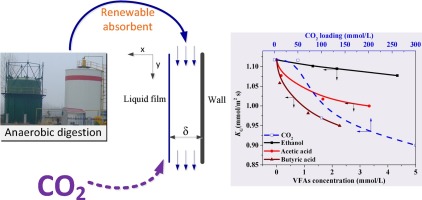International Journal of Greenhouse Gas Control ( IF 4.6 ) Pub Date : 2018-08-07 , DOI: 10.1016/j.ijggc.2018.07.027 Qingyao He , Long Ji , Bing Yu , Shuiping Yan , Yanlin Zhang , Shuaifei Zhao

|
Renewable aqueous ammonia (RAA) can be recovered from biogas slurry by vacuum membrane distillation (VMD). Bio-natural gas can be produced from biogas after removing its CO2 using RAA as the CO2 absorbent. However, RAA contains some impurities, e.g. organic carbon (mainly the volatile fatty acids, VFAs) and inorganic carbon (mainly the dissolved CO2) that may influence its CO2 absorption performance. In this study, RAA was firstly recovered by VMD to investigate the concentrations of free ammonia and impurities in RAA changed with the initial total ammonia nitrogen (TAN) concentration. Then CO2 absorption performance of RAA was investigated in a wetted-wall column, and compared with the unloaded aqueous ammonia (AA). Through VMD, higher TAN concentration of RAA up to 2.4 mol-N/L can be achieved. Due to higher pH value (10.7–11.5), higher than 99% of N element is formed as free ammonia. Additionally, CO2 and some VFAs mainly including ethanol, acetic acid, propionic acid and butyric acid can be extracted from biogas slurry and transferred into RAA. However, their concentrations are much lower than free ammonia in RAA. Furthermore, at 2 mol-N/L, the second-order reaction constant (k2) of RAA is about 4306 L/mol s at 298 K, which is slightly lower than that of AA (4772 L/mol s) due to the negative effect of VFAs. The average overall mass transfer coefficients of RAA are lower by 4.67%–17.31% than that of unloaded aqueous ammonia. Furthermore, increasing the concentration of VFAs and CO2 loading in RAA leads to a rapid decline of the overall mass transfer coefficient of CO2. Butyric acid has the greatest negative impact on CO2 absorption, followed by acetic acid, ethanol and then CO2. However, the increase of TAN concentration in RAA can minimize the negative influence of impurities on CO2 absorption performance.
中文翻译:

沼液中可再生的氨水用于碳捕集:化学成分和CO 2吸收率
可以通过真空膜蒸馏(VMD)从沼气浆液中回收可再生的氨水(RAA)。使用RAA作为CO 2吸收剂去除沼气中的CO 2后,可以从沼气中生产生物天然气。但是,RAA包含一些杂质,例如有机碳(主要是挥发性脂肪酸,VFA)和无机碳(主要是溶解的CO 2),这些杂质可能会影响其CO 2的吸收性能。在这项研究中,首先通过VMD回收了RAA,以研究RAA中游离氨和杂质的浓度随初始总氨氮(TAN)浓度的变化而变化。然后CO 2在湿壁色谱柱中研究了RAA的吸收性能,并与未加载的氨水(AA)进行了比较。通过VMD,可以实现更高的RAA TAN浓度,最高可达2.4 mol-N / L。由于较高的pH值(10.7-11.5),高于99%的N元素以游离氨的形式形成。另外,可以从沼气浆液中提取CO 2和一些主要包括乙醇,乙酸,丙酸和丁酸的VFA,并将其转移到RAA中。但是,它们的浓度远低于RAA中的游离氨。此外,在2 mol-N / L时,二级反应常数(k 2在298 K时,RAA的ΔF约为4306 L / mol s,由于VFA的负面影响,它比AA的4772 L / mol s略低。RAA的平均总体传质系数比未加载氨水的传质系数低4.67%–17.31%。此外,增加的VFA和CO的浓度2装载在RAA导致CO的总传质系数的快速下降2。丁酸对CO 2的吸收具有最大的负面影响,其次是乙酸,乙醇和CO 2。但是,RAA中TAN浓度的增加可以最小化杂质对CO 2吸收性能的负面影响。











































 京公网安备 11010802027423号
京公网安备 11010802027423号